Also known as the “Sunflower State”, Kansas is a large and popular state in the midwestern region of the U.S. It has a vast array of habitats – including Mount Sunflower (which isn’t a true mountain), which is its highest point in the state at 4,039 feet. The famous Missouri River borders Kansas along its northeastern edge, but there are also many other rivers that flow through it, including its namesake: Kansas River. As well as river valleys and mountains, Kansas has great plains and thick forest regions. All of these habitats are teeming with wildlife both large and small.
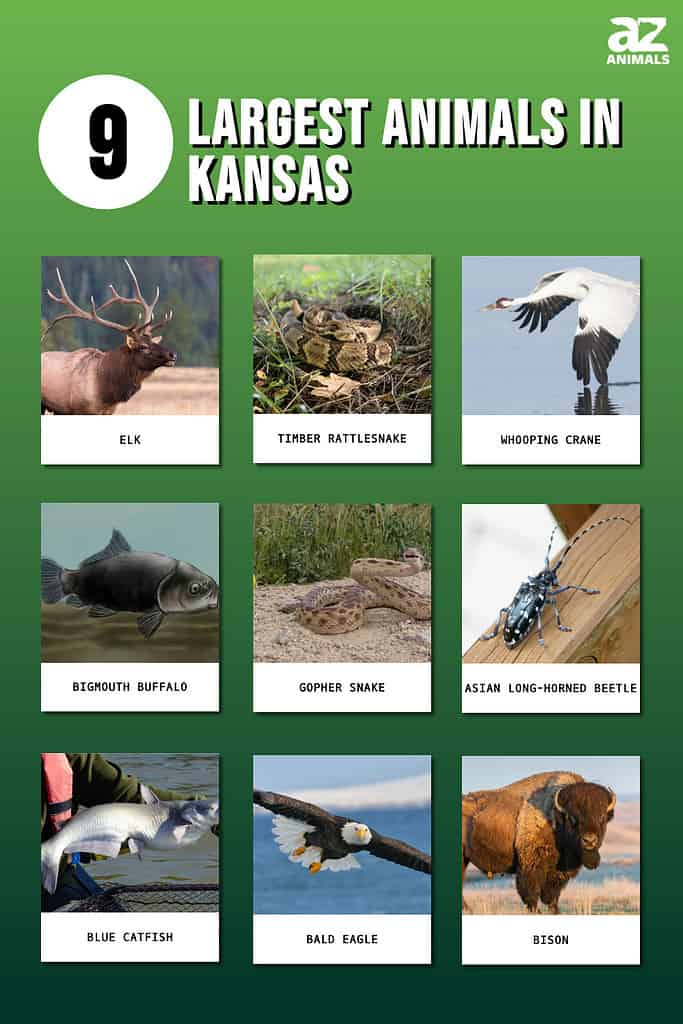
So join us as we discover some of the largest animals in Kansas and where you’ll find them!
1. Elk
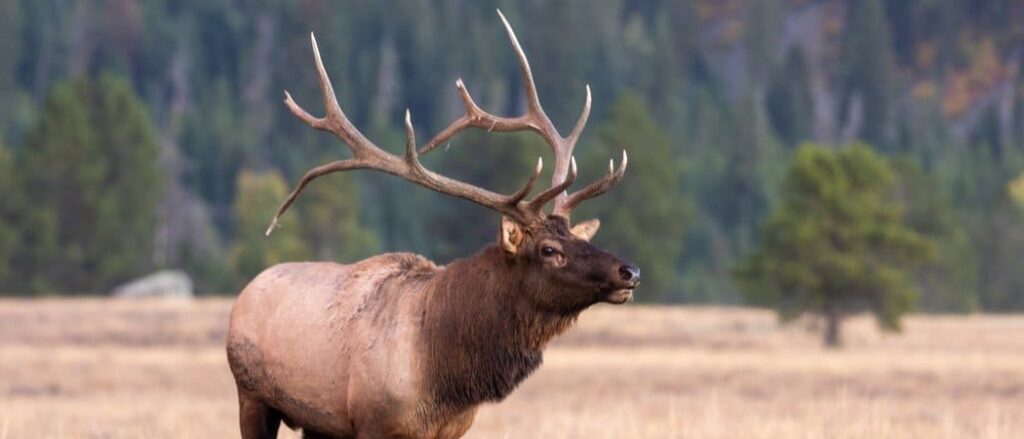
Elk were once
extinct
in Kansas but have been successfully reintroduced to the state.
©twildlife/Shutterstock.com
Elk were once common across Kansas, but settlers in the 1800’s encroached on their habitat and drove them out of the state. However, these stunning animals have since been reintroduced, and there is now a 120 strong herd of wild elk living in Fort Riley. Also known as the wapiti, elk are large members of the deer family that weigh up to 1,300 pounds and have a maximum shoulder height of 4 feet, 11 inches. Elk are herbivores and prefer to browse rather than graze. They live in a range of habitats, and although they favor open grasslands in particular, they can also live in woodlands and forest edges.
2. Timber Rattlesnake
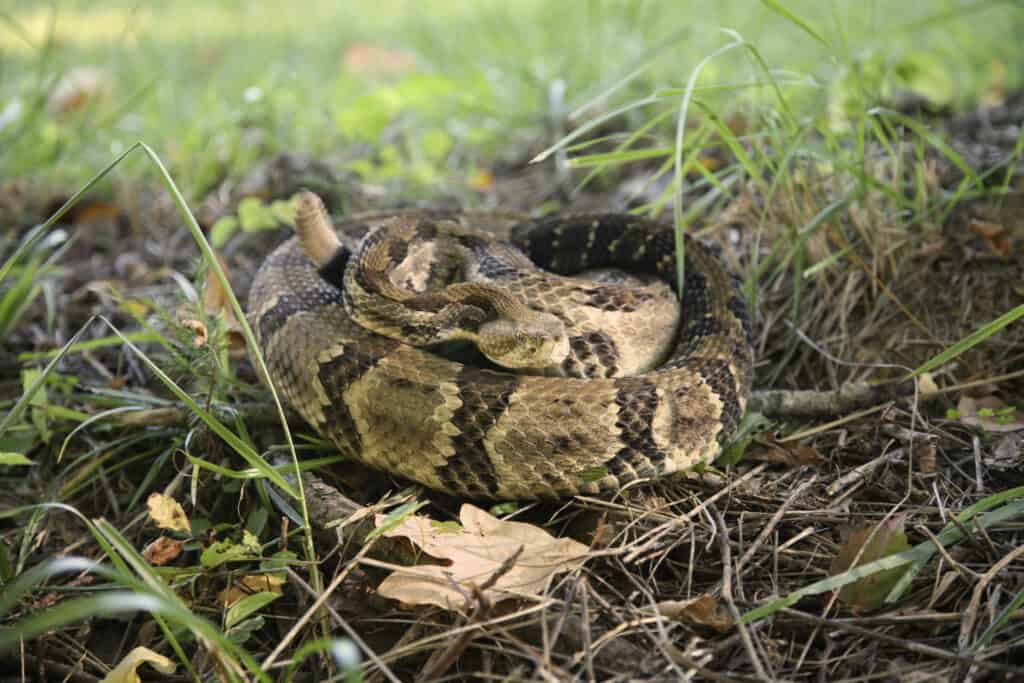
Timber Rattlesnakes
are extremely venomous, but they are not typically aggressive.
©iStock.com/NajaShots
Of the four venomous snakes in Kansas, the longest is the timber rattlesnake. Timber rattlesnakes are 3 to 5 feet long and are a yellowish brown color with dark brown or black crossband markings. They are secretive snakes and generally live in thick forest habitats, although females often prefer rocky outcrops known as “basking knolls”. Timber rattlesnakes only live in the eastern region of Kansas. These snakes are highly venomous as they contain large amounts of venom and possess long fangs with which to inject it with. However, they often have a mild manner and usually rattle their tail in warning before they actually bite.
3. Whooping Crane
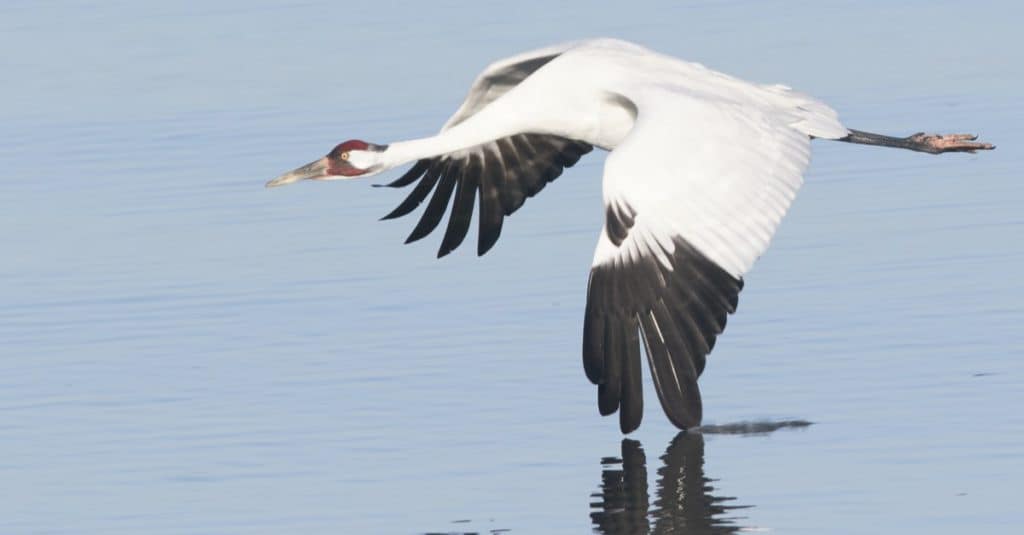
Whooping cranes are the tallest birds in North America.
©Kent Ellington/Shutterstock.com
One of the largest animals in Kansas is the endangered whooping crane which is also the tallest bird in North America. Standing between 4 feet, 1 inch and 5 feet, 3 inches tall and with a wingspan that can reach 7 feet, 7 inches, these are huge birds. Whooping cranes have white bodies with black wing tips, a black bill, and a bright red crown on their head. They have a distinctive call that you can often hear from several miles away. Whooping cranes are wading birds and typically live near wetland areas so that they can forage in the shallows. They are omnivores and eat a mixture of plant material, fish, frogs, rodents, and small birds. Whooping cranes are migratory and pass through Kansas from March to April and October to November. A popular location to see them is Cheyenne Bottoms Preserve.
4. Bigmouth Buffalo
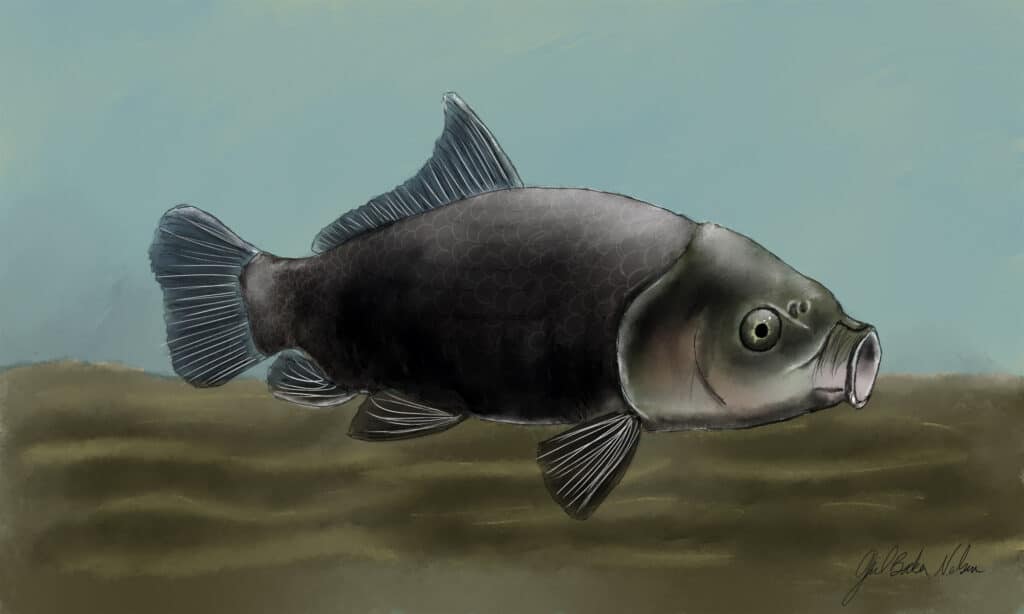
Although its name would suggest that it is a mammal, the bigmouth buffalo is actually a fish. Bigmouth buffalo are the largest members of the Catostomidae (sucker) family group. They are freshwater fish and are incredibly slow to mature and have extremely long lifespans – living to approximately 110 years old. Bigmouth buffalo are native to North America and prefer to live in slow moving water, such as large rivers and lakes. They are usually a brownish green color with long dorsal fins and a forward-facing mouth. Bigmouth buffalo can reach 4 feet long and weigh up to 40 pounds. The largest bigmouth buffalo caught in Kansas came from Cheney Reservoir in June 2019. It was 45.75 inches long and weighed 62.5 pounds. Bigmouth buffalo are common across Kansas and prey mainly on insect larvae, crustaceans, and zooplankton.
5. Gopher Snake
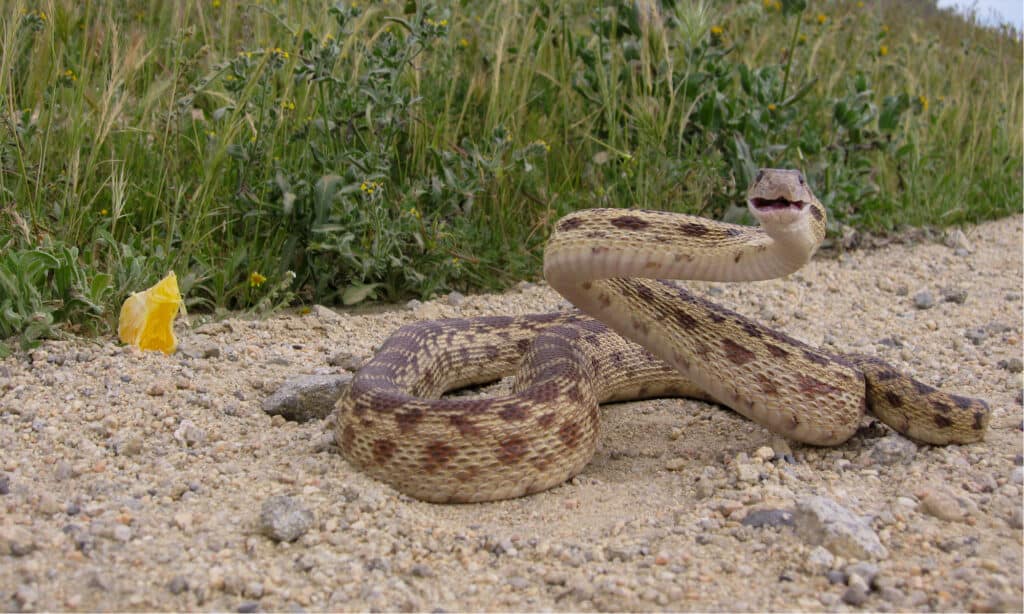
A gopher snake is coiled up and ready to strike. Although they may resemble some rattlesnakes, gopher snakes are not venomous.
©rawaccess/Shutterstock.com
Easily one of the largest animals in Kansas is the gopher snake which can reach lengths of up to 9 feet. These snakes are typically a yellowish-brown color with dark brown or black spots and blotches on them. Although they are not venomous many people often mistake them for the venomous prairie rattlesnake. When threatened they often mimic a rattlesnake by puffing themselves up and rearing up off the ground while vibrating their tails. Gopher snakes are constrictors and prey mainly on animals such as rodents and small birds. Pocket gophers are a particular favorite of these snakes. Gopher snakes are widely distributed and live in a variety of habitats such as prairies, deserts, forests, and fields. In Kansas they can often be found in the Flint Hills.
6. Asian Long-Horned Beetle
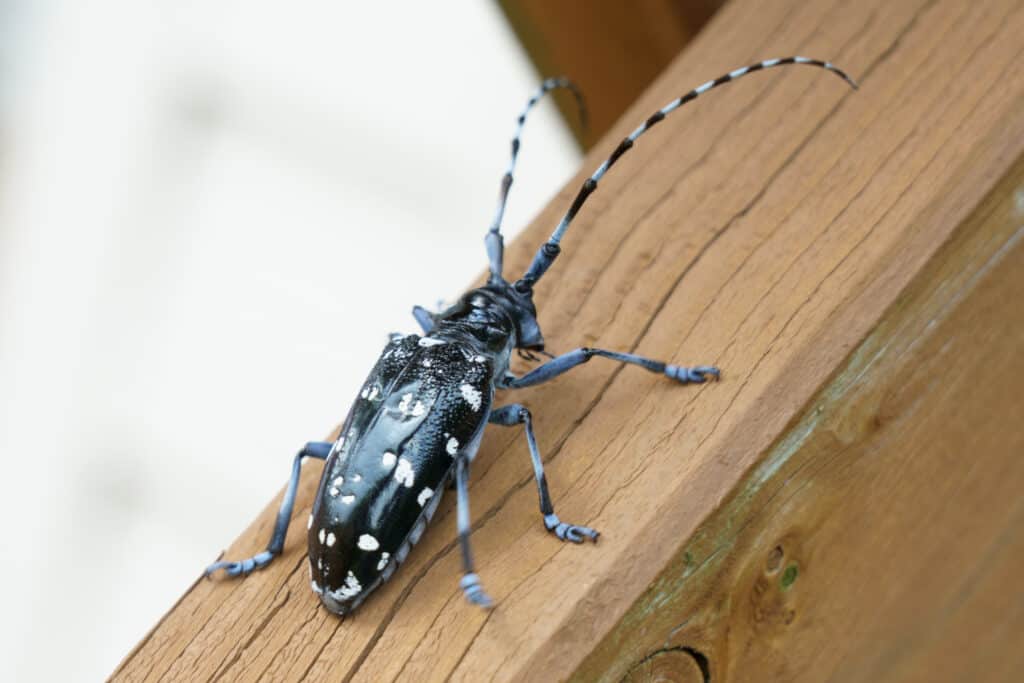
Asian long-horned beetles are highly destructive to trees and are often classed as pests.
©High Mountain/Shutterstock.com
Easily one of the biggest insects in Kansas is the Asian long-horned beetle. It is up to 1.5 inches long and has antennas approximately two times longer than its body. Asian long-horned beetles are native to China and Korea but were introduced to the U.S. and many other countries and are now an invasive species. The larvae of Asian long-horned beetles feed on the wood of deciduous trees, which can be extremely damaging. In Kansas they threaten many hardwood trees across the state.
7. Blue Catfish
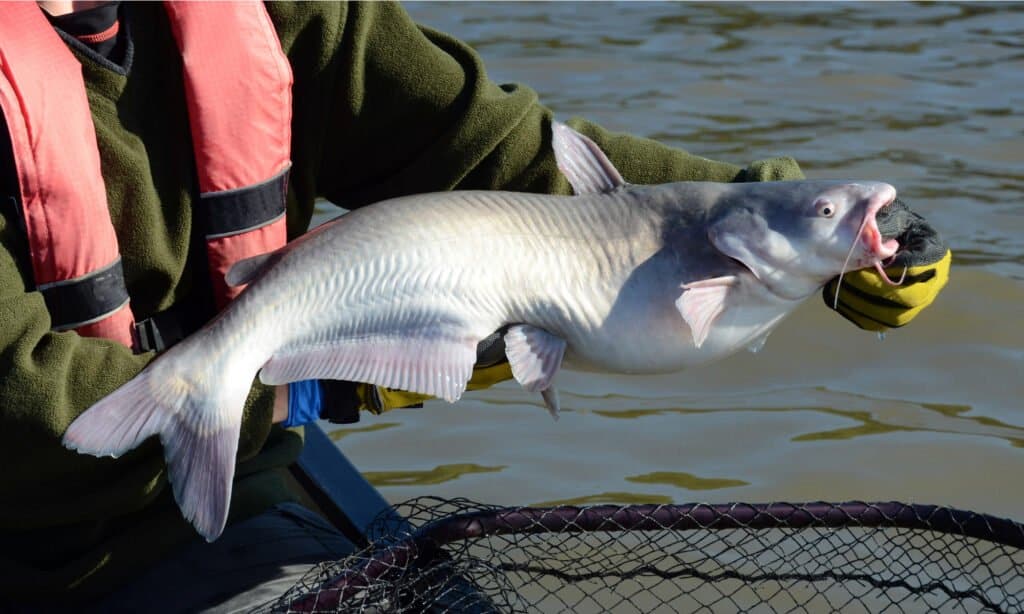
Blue
Catfish
are the largest of the North American catfish and can weigh 150 pounds.
©M Huston/Shutterstock.com
One of the largest animals in Kansas is the blue catfish which is also the largest of the North American catfish. These huge fish can reach 5 feet, 5 inches long and weigh up to 150 pounds. The largest in Kansas was 56.75 inches long and weighed a touch under 103 pounds. Blue catfish are a blueish grey color and have thick, heavy bodies. They often live in freshwater but can also tolerate brackish water. Blue catfish are carnivorous fish and prey on virtually anything they can catch – such as crawfish, frogs, mussels, and a wide variety of fish. Due to this nature, they are often classed as a pest in many areas. In Kansas they occur in most reservoirs and lakes across the state, with some of the best places being Pomona Reservoir and LaCygne Reservoir.
8. Bald Eagle

Bald Eagles have a huge wingspan of 7 feet, 7 inches.
©Jack Molan/Shutterstock.com
The largest bird in Kansas is the bald eagle which has a massive wingspan of up to 7 feet, 7 inches. Bald eagles weigh between 6.6 and 14 pounds and females are larger than males. They are distinctive birds with their dark brown bodies and white heads and tails. Bald eagles are sea eagles, and they live near large bodies of water such as around coastlines and lakes. They mainly eat fish which they catch by swooping down and scooping them straight out of the water using their sharp talons. However, they occasionally eat small mammals too. Bald eagles frequent Kansas during the winter and around 3,000 of them arrive in the state every November before they return to their breeding grounds in March. Some of the best places to see them include Tuttle Creek Lake, Clinton Lake, and Milford Lake.
9. Bison

Bison are huge animals and stand approximately 6 feet, 7 inches high at the shoulder.
©iStock.com/Jillian Cooper
The largest animal in Kansas is the massive American bison. These immense animals can stand 6 feet, 7 inches at the shoulder and reach weights of up to 3,000 pounds. Bulls are heavier than the females, but both have a set of short, curved horns. Bison are herbivores and roam the land in great herds. However, females and calves live in one herd while males live together in “bachelor herds”. Young males leave their mothers’ herd at around three years old. Males and females generally only interact during the mating season from July to September. Bison typically live in open and semi-open grassland areas. They were hunted to extinction in Kansas in 1886 but have now been successfully reintroduced to the state. Today, there are more than 200,000 bison in Kansas and some of the best places to see them include Tallgrass Prairie National Preserve and Konza Prairie.
Summary of the 9 Largest Animals in Kansas
| Name of Animal | Size | Habitat |
|---|---|---|
| Elk | 4’11” at shoulder; 1,300 lbs. | Grasslands, mostly; also woodlands and forest edges. |
| Timber Rattlesnake | 3-5 ft. long | Rocky outcroppings |
| Whooping Crane | 4’1″-5’3″ tall; 7’7″ wingspan | Near wetland area |
| Bigmouth Buffalo | up to 4 ft.; up to 40 lbs. | Slow waters of rivers and lakes |
| Gopher Snake | up to 9 ft. long | Widespread |
| Asian Long-horned Beetle | 1.5 inches long | Deciduous trees, particularly hardwoods |
| Blue Catfish | up to 5’5″; up to 150 lbs. | Most lakes and reservoirs |
| Bald Eagle | wingspan 7’7″; 6.6-14 lbs. | Near large bodies of water in winter. |
| Bison | 6’7″ at shoulder; up to 3,000 lbs. | Open and semi-open grassland |
The photo featured at the top of this post is © Grey Mountain Photo/Shutterstock.com
Sources
- US Department of Agriculture (1970) https://www.aphis.usda.gov/aphis/resources/pests-diseases/hungry-pests/pest-tracker/states/kansas
- Kansas Department of Wildlife and Parks, Available here: https://ksoutdoors.com/Services/Threatened-and-Endangered-Wildlife/All-Threatened-and-Endangered-Species/Timber-Rattlesnake
- Kansas State University, Available here: https://keep.konza.k-state.edu/prairieecology/bison.html
Thank you for reading! Have some feedback for us? Contact the AZ Animals editorial team.






